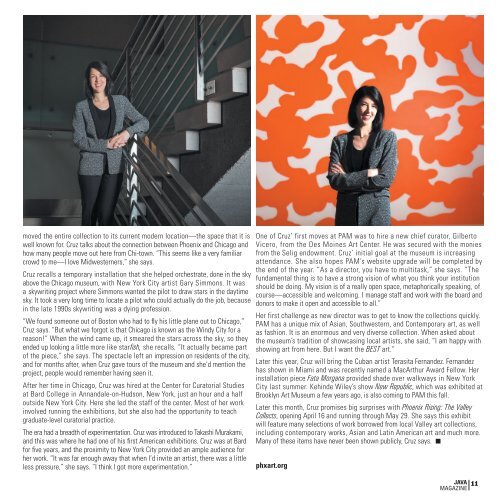You also want an ePaper? Increase the reach of your titles
YUMPU automatically turns print PDFs into web optimized ePapers that Google loves.
moved the entire collection to its current modern location—the space that it is<br />
well known for. Cruz talks about the connection between Phoenix and Chicago and<br />
how many people move out here from Chi-town. “This seems like a very familiar<br />
crowd to me—I love Midwesterners,” she says.<br />
Cruz recalls a temporary installation that she helped orchestrate, done in the sky<br />
above the Chicago museum, with New York City artist Gary Simmons. It was<br />
a skywriting project where Simmons wanted the pilot to draw stars in the daytime<br />
sky. It took a very long time to locate a pilot who could actually do the job, because<br />
in the late 1990s skywriting was a dying profession.<br />
“We found someone out of Boston who had to fly his little plane out to Chicago,”<br />
Cruz says. “But what we forgot is that Chicago is known as the Windy City for a<br />
reason!” When the wind came up, it smeared the stars across the sky, so they<br />
ended up looking a little more like starfish, she recalls. “It actually became part<br />
of the piece,” she says. The spectacle left an impression on residents of the city,<br />
and for months after, when Cruz gave tours of the museum and she’d mention the<br />
project, people would remember having seen it.<br />
After her time in Chicago, Cruz was hired at the Center for Curatorial Studies<br />
at Bard College in Annandale-on-Hudson, New York, just an hour and a half<br />
outside New York City. Here she led the staff of the center. Most of her work<br />
involved running the exhibitions, but she also had the opportunity to teach<br />
graduate-level curatorial practice.<br />
The era had a breadth of experimentation. Cruz was introduced to Takashi Murakami,<br />
and this was where he had one of his first American exhibitions. Cruz was at Bard<br />
for five years, and the proximity to New York City provided an ample audience for<br />
her work. “It was far enough away that when I’d invite an artist, there was a little<br />
less pressure,” she says. “I think I got more experimentation.”<br />
One of Cruz’ first moves at PAM was to hire a new chief curator, Gilberto<br />
Vicero, from the Des Moines Art Center. He was secured with the monies<br />
from the Selig endowment. Cruz’ initial goal at the museum is increasing<br />
attendance. She also hopes PAM’s website upgrade will be completed by<br />
the end of the year. “As a director, you have to multitask,” she says. “The<br />
fundamental thing is to have a strong vision of what you think your institution<br />
should be doing. My vision is of a really open space, metaphorically speaking, of<br />
course—accessible and welcoming. I manage staff and work with the board and<br />
donors to make it open and accessible to all.”<br />
Her first challenge as new director was to get to know the collections quickly.<br />
PAM has a unique mix of Asian, Southwestern, and Contemporary art, as well<br />
as fashion. It is an enormous and very diverse collection. When asked about<br />
the museum’s tradition of showcasing local artists, she said, “I am happy with<br />
showing art from here. But I want the BEST art.”<br />
Later this year, Cruz will bring the Cuban artist Terasita Fernandez. Fernandez<br />
has shown in Miami and was recently named a MacArthur Award Fellow. Her<br />
installation piece Fata Morgana provided shade over walkways in New York<br />
City last summer. Kehinde Wiley’s show New Republic, which was exhibited at<br />
Brooklyn Art Museum a few years ago, is also coming to PAM this fall.<br />
Later this month, Cruz promises big surprises with Phoenix Rising: The Valley<br />
Collects, opening April 16 and running through May 29. She says this exhibit<br />
will feature many selections of work borrowed from local Valley art collections,<br />
including contemporary works, Asian and Latin American art and much more.<br />
Many of these items have never been shown publicly, Cruz says.<br />
phxart.org<br />
JAVA 11<br />
MAGAZINE


















